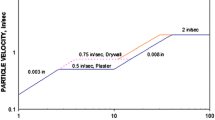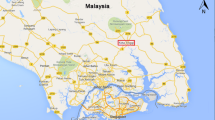Abstract
Ground vibration is an adverse effect induced by rock blasting in civil and mining projects. Peak particle velocity is the most important descriptor to evaluate the ground vibration in the blasting sites. The present paper proposes an adaptive neuro-fuzzy inference system (ANFIS) for simulating the PPV in Shur River Dam area, Iran. For checking the ANFIS performance in simulating the PPV, a linear regression model is also used. To achieve the objective of this research, 90 blasting operations were monitored in the mentioned site and the values of weight charge per delay and distance between the blasting face and the installed seismograph, as the most effective parameters on the PPV, were measured. Using magnitude of three error indices, i.e., coefficient of correlation, variance account for and root mean square error, we proved that the proposed ANFIS model can simulate the PPV with a high degree of accuracy and reliability. The values of the coefficient of correlation obtained from the ANFIS and linear regression models were 0.983 and 0.876, respectively, that indicate the ANFIS outperforms the linear regression model.










Similar content being viewed by others
References
Monjezi M, Rezaei M, Yazdian A (2010) Prediction of backbreak in open-pit blasting using fuzzy set theory. Expert Syst Appl 37(3):2637–2643
Rezaei M, Monjezi M, Varjani AY (2011) Development of a fuzzy model to predict flyrock in surface mining. Saf sci 49(2):298–305
Hasanipanah M, Armaghani DJ, Monjezi M, Shams S (2016) Risk assessment and prediction of rock fragmentation produced by blasting operation: a rock engineering system. Environ Earth Sci 75(9):808
Hasanipanah M et al (2017) Development of a precise model for prediction of blast-induced flyrock using regression tree technique. Environ Earth Sci 76(1):27
Behzadafshar K, Sarafraz ME, Hasanipanah M, Mojtahedi SFF, Tahir MM (2017) Proposing a new model to approximate the elasticity modulus of granite rock samples based on laboratory tests results. Bull Eng Geol Env. https://doi.org/10.1007/s10064-017-1210-5
Hasanipanah M, Shahnazar A, Arab H, Golzar SB, Amiri M (2017) Developing a new hybrid-AI model to predict blast-induced backbreak. Eng Comput 33(3):349–359
Gao W, Karbasi M, Hasanipanah M, Zhang X, Guo J (2018) Developing GPR model for forecasting the rock fragmentation in surface mines. Eng Comput 34(2):339–345
Hasanipanah M, Armaghani DJ, Amnieh HB, Koopialipoor M, Arab H (2018) A risk-based technique to analyze flyrock results through rock engineering system. Geotech Geol Eng 36:2247–2260
Rad HN, Hasanipanah M, Rezaei M, Eghlim AL (2018) Developing a least squares support vector machine for estimating the blast-induced flyrock. Eng Comput 34(4):709–717
Keshtegar B, Hasanipanah M, Bakhshayeshi I, Sarafraz ME (2019) A novel nonlinear modeling for the prediction of blast-induced airblast using a modified conjugate FR method. Measurement 131:35–41
Faradonbeh RS, Armaghani DJ, Majid MA, Tahir MM, Murlidhar BR, Monjezi M, Wong HM (2016) Prediction of ground vibration due to quarry blasting based on gene expression programming: a new model for peak particle velocity prediction. Int J Environ Sci Technol 13(6):1453–1464
Monjezi M, Baghestani M, Faradonbeh RS, Saghand MP, Armaghani DJ (2016) Modification and prediction of blast-induced ground vibrations based on both empirical and computational techniques. Eng Comput 32(4):717–728
Mohamadnejad M, Gholami R, Ataei M (2012) Comparison of intelligence science techniques and empirical methods for prediction of blasting vibrations. Tunn Undergr Space Technol 28:238–244
Mohamad ET, Noorani SA, Armaghani DJ, Saad R (2012) Simulation of blasting induced ground vibration by using artificial neural network. Electron J Geotech Eng 17:2571–2584
Monjezi M, Hasanipanah M, Khandelwal M (2013) Evaluation and prediction of blast-induced ground vibration at Shur River Dam, Iran, by artificial neural network. Neural Comput Appl 22(7–8):1637–1643
Hasanipanah M, Monjezi M, Shahnazar A, Jahed Armaghani D, Farazmand A (2015) Feasibility of indirect determination of blast induced ground vibration based on support vector machine. Measurement 75:289–297
Amiri M, Bakhshandeh Amnieh H, Hasanipanah M, Mohammad Khanli L (2016) A new combination of artificial neural network and K-nearest neighbors models to predict blast-induced ground vibration and air-overpressure. Eng Comput 32:631–644. https://doi.org/10.1007/s00366-016-0442-5
Behzadafshar K et al (2018) Predicting the ground vibration induced by mine blasting using imperialist competitive algorithm. Eng Comput 35(4):1774–1787
Hasanipanah M, Shirani Faradonbeh R, Bakhshandeh Amnieh H, Jahed Armaghani D, Monjezi M (2017) Forecasting blast induced ground vibration developing a CART model. Eng Comput 33(2):307–316
Hasanipanah M et al (2016) Prediction of an environmental issue of mine blasting: an imperialistic competitive algorithm-based fuzzy system. Int J Environ Sci Technol. https://doi.org/10.1007/s13762-017-1395-y
Davies B, Farmer IW, Attewell PB (1964) Ground vibrations from shallow sub-surface blasts. Engineer 217:553–559
Ambraseys NR, Hendron AJ (1968) Dynamic behavior of rock masses: rock mechanics in engineering practices. Wiley, London
Dowding CH (1985) Blast vibration monitoring and control. Prentice-Hall, Englewoods Cliffs, pp 288–290
Roy PP (1993) Putting ground vibration predictors into practice. J Colliery Guard 241:63–67
Rai R, Singh TN (2004) A new predictor for ground vibration prediction and its comparison with other predictors. Indian J Eng Mater Sci 11:178–184
Mohammadhassani M, Nezamabadi-pour H, Shariati M, Suhatril M (2013) Identification of a suitable ANN architecture in predicting strain in tie section of concrete deep beams. Struct Eng Mech 46(6):853–868
Toghroli A, Mohammadhassani M, Shariati M, Suhatril M, Ibrahim Z, Ramli Sulong NH (2014) Prediction of shear capacity of channel shear connectors using the ANFIS model. Steel Compos Struct J 17(5):623–639
Azar SA, Ahangarnejad AH (2014) Simulating the diesel engine vibration with fuzzy neural network. Res J Appl Sci Eng Technol 8(9):1045–1051
Rezaei M, Asadizadeh M, Majdi A, Farouq Hossaini M (2016) Prediction of representative deformation modulus of longwall panel roof rock strata using Mamdani fuzzy system. Int J Min Sci Technol 25:23–30
Rezaei M (2016) Development of an intelligent model to estimate the height of caving–fracturing zone over the longwall gobs. Neural Comput Appl. https://doi.org/10.1007/s00521-016-2809-3
Hasanipanah M, Noorian-Bidgoli M, Armaghani DJ, Khamesi H (2016) Feasibility of PSO-ANN model for predicting surface settlement caused by tunneling. Eng Comput 32(4):705–715
Mojtahedi SFF, Ebtehaj I, Hasanipanah M, Bonakdari H, Amnieh HB (2018) Proposing a novel hybrid intelligent model for the simulation of particle size distribution resulting from blasting. Eng Comput. https://doi.org/10.1007/s00366-018-0582-x
Faradonbeh RS, Hasanipanah M, Amnieh HB, Armaghani DJ, Monjezi M (2018) Development of GP and GEP models to estimate an environmental issue induced by blasting operation. Environ Monit Assess 190(6):351
Rezaei M (2018) Forecasting the stress concentration coefficient around the mined panel using soft computing methodology. Eng Comput. https://doi.org/10.1007/s00366-018-0608-4
Hasanipanah M, Amnieh HB, Arab H, Zamzam MS (2018) Feasibility of PSO–ANFIS model to estimate rock fragmentation produced by mine blasting. Neural Comput Appl 30(4):1015–1024
Jahed Armaghani D, Hasanipanah M, Bakhshandeh Amnieh H, Mohamad ET (2016) Feasibility of ICA in approximating ground vibration resulting from mine blasting. Neural Comput Appl. https://doi.org/10.1007/s00521-016-2577-0
Hasanipanah M, Golzar SB, Larki IA, Maryaki MY, Ghahremanians T (2017) Estimation of blast-induced ground vibration through a soft computing framework. Eng Comput 33(4):951–959
Taheri K, Hasanipanah M, Bagheri Golzar S, Abd Majid MZ (2016) A hybrid artificial bee colony algorithm-artificial neural network for forecasting the blast-produced ground vibration. Eng Comput 33(3):689–700
Fouladgar N, Hasanipanah M, Bakhshandeh Amnieh H (2017) Application of cuckoo search algorithm to estimate peak particle velocity in mine blasting. Eng Comput 33(2):181–189
Hasanipanah M, Naderi R, Kashir J, Noorani SA, Zeynali Aaq Qaleh A (2016) Prediction of blast produced ground vibration using particle swarm optimization. Eng Comput 33(2):173–179. https://doi.org/10.1007/s00366-016-0462-1
Zadeh LA (1965) Fuzzy sets. Inf Control 8:338–353
Yurdusev MA, Firat M, Turan M (2009) Adaptive neuro fuzzy inference system approach for municipal water consumption modeling: an application to Izmir. Turkey J Hydrol 365(3–4):225–234
Takagi KI, Sugeno M (1985) Fuzzy identification of systems and its applications to modeling and control. IEEE Trans On Systems Man Cybern 15(1):116–132
Jang JSR (1993) ANFIS: adaptive network based fuzzy inference system. IEEE Trans Syst Manage Cybern 23(3):665–685
Chelang AA, Abulkarim A, Adnan IA (2018) Prediction of discharge coefficient for cylindrical weirs using adaptive neuro fuzzy inference system ANFIS and multilayer neural networks MLP. Int J Appl Eng Res 13(9):7042–7051
Chokmani K, Ouarda TMJ, Hamulton S et al (2008) Comparison of ice affected streamflow estimates computed using artificial neural networks and multiple regression techniques. J Hydrol 349:383–396
Teryaki S, ozsahin S, Yildirim I (2014) Comparison of artificial neural network and multiple linear regression models to predict optimum bonding strength of heat treated woods. Int J Adhes Adhes 55:29–36
Monjezi M, Rezaei M, Varjani AY (2009) Prediction of rock fragmentation due to blasting in Gol-E-Gohar iron mine using fuzzy logic. Int J Rock Mech Min Sci 46(8):1273–1280
Monjezi M, Rezaei M (2011) Developing a new fuzzy model to predict burden from rock geomechanical properties. Expert Syst Appl 38(8):9266–9273
Armaghani DJ, Hasanipanah M, Mohamad ET (2016) A combination of the ICA-ANN model to predict air-overpressure resulting from blasting. Eng Comput 32(1):155–171
Hasanipanah M, Armaghani DJ, Khamesi H, Amnieh HB, Ghoraba S (2016) Several non-linear models in estimating air-overpressure resulting from mine blasting. Eng Comput 32(3):441–455
Mohamad ET, Armaghani DJ, Hasanipanah M, Murlidhar BR, Alel MNA (2016) Estimation of air-overpressure produced by blasting operation through a neuro-genetic technique. Environ Earth Sci 75(2):174
Hasanipanah M, Armaghani DJ, Amnieh HB, Majid MZA, Tahir MMD (2017) Application of PSO to develop a powerful equation for prediction of flyrock due to blasting. Neural Comput Appl 28(1):1043–1050
Acknowledgements
This research was supported by the Natural Science Foundation of Guangdong Province, Grant nos. 2016A030313703 and 2018A030313061. The Guangdong Science and Technology Plan, Grant no. 2016B030305002. In addition, the corresponding author would like to express his sincere appreciation and gratitude to A.S. al-Mahdi for his initiation, supervision and guidance throughout the period of research.
Author information
Authors and Affiliations
Corresponding author
Additional information
Publisher’s Note
Springer Nature remains neutral with regard to jurisdictional claims in published maps and institutional affiliations.
Rights and permissions
About this article
Cite this article
Jiang, W., Arslan, C.A., Soltani Tehrani, M. et al. Simulating the peak particle velocity in rock blasting projects using a neuro-fuzzy inference system. Engineering with Computers 35, 1203–1211 (2019). https://doi.org/10.1007/s00366-018-0659-6
Received:
Accepted:
Published:
Issue Date:
DOI: https://doi.org/10.1007/s00366-018-0659-6




